Updated August 9, 2024
When purchasing a prepaid mobile travel plan for your phone, it’s helpful to have desirable criteria and features in mind. My own list had served me well until the inconvenient and costly experience of buying a SIM card in Italy on my last trip. As a result, I’ve added two more to my list, and developed several tips for finding the perfect prepaid plan.
Criteria for buying a local SIM card
- For talk, text, and data, a physical SIM card and prepaid plan offer several advantages over a data-only eSIM plan.
- Buying a SIM card and plan in the destination country places setup in the hands of experts.
- The ability to get set up with a prepaid plan at the point of arrival offers convenience and security. It facilitates connecting with an accommodation host, ordering a ride, navigating routes, looking up information, accessing bookings, and more… all contributing to feeling a little more comfortable in an unfamiliar place.
- The plan is valid for the entire visit, and automatically expires at the end of the period of coverage.
- Daily, weekly and monthly rates offer flexibility and affordability for shorter and longer stays.
- There’s cellular coverage for all destinations on the itinerary.
- The plan comes with unlimited domestic talk, or a sufficient amount of calling minutes to make in-country calls to stay in touch with friends and travelling companions, book travel, or use in an emergency. Some plans include free network-to-network calls (e.g., Lyca-to-Lyca or Vodafone-to-Vodafone) so in-country calls to travelling companions on the same mobile network don’t use any calling credit.
- It has unlimited international talk (or enough credit in minutes) to make calls to landlines such as banks or an emergency medical insurance administrator in your home country.
- It has sufficient data to access the internet for travel research, navigation, email management, posting to social media, and VoIP calls over WhatsApp, Skype, Messenger, or similar platforms.
- The plan allows tethering to use the phone as a hotspot to pair with a tablet.
- It has the ability to conveniently buy additional calling minutes or data.
- There’s access to an app or an online account to track usage.
- If travelling to other countries, EU roaming involves a fully portable plan where calling features and data consumption are the same as those in the purchasing country. If not, the terms are clear at the point of purchase.
Learn from my mistake. After my experience buying a SIM card in Italy, I’ve realized how important it is to have:
- activation take effect BEFORE leaving the store. Or, to have the ability to return to the store if things don’t unfold as planned; and
- access to information in your own language. At the very least, it’s helpful if the website offers multilingual information on products and services available to travellers. Better still, a multilingual live chat feature is useful for clarifying information or troubleshooting.
My experience buying a SIM card in Italy
Pre-trip-research
Pre-trip research wasn’t revealing any mobile network kiosks or shops at Pisa International Airport. Besides, I was arriving close to midnight, and figured I’d have time to get set up the following day before catching a train to the Cinque Terre.
My usual starting point for pre-trip research is Buying SIM Cards and eSIMs Around the World at Too Many Adapters. Forums such as Reddit or the Rick Steves’ Travel Forum are another source of updated information based on travellers’ experiences nd reviews. I learned that:
- TIM and Vodafone (and resellers using their networks) used to have the largest networks. However, W3 (WINDTRE, created after a merger of WIND and 3) has the widest coverage.
- Lyca Mobile has cheap prepaid rates and uses the widespread Vodafone network.
My search for a plan
From our overnight base at the Hotel Terminus and Plaza near the train station, it was a leisurely stroll up to the leaning tower. I figured chances were good that I’d stumble across a full-service outlet. That was indeed the case in a busy pedestrian shopping street with WIND (before the merger with 3) and Vodafone stores. I signed up with Vodafone.
The Vodafone store at Corso Italia 36 had a C’all Global promotion. For a total cost of €25, a 30-day plan included 8 GB of data, calls within Italy, calling minutes to select countries, and EU roaming.
Set up went well. I’d left my passport back at the hotel, but I always carry a laminated copy of my passport’s information page. That was all that was needed. The electronic version of the contract was signed, and sent to my email address. My Canadian SIM card was taped to the empty SIM card holder, and my phone’s Wi-Fi hotspot was activated. I paid in cash, and received a receipt. The whole process took about twenty minutes.
Then came the news that the plan would be activated in five hours. The worker assured me that all I needed to do was take my phone off Airplane Mode and I’d have service.
Issues with Vodafone
After five hours, I disabled Airplane Mode, and a text from Vodafone indicated I had service. “Vodafone” appeared as my cellular carrier on the home screen, with a sufficient number of bars indicating service. However, no amount of fiddling with settings gave me data or calling capabilities. Calling our VRBO accommodation hosts in the Cinque Terre resulted in a voice recording, in Italian, indicating I had no credit.
The Vodafone-Italy website was in Italian only, and had no live chat feature that I could find. If there was an option to speak to an agent, I couldn’t find that either. After unsuccessfully adjusting and readjusting my settings, I headed for the nearest Vodafone store early the next day.
It was in La Spezia, one train and one taxi ride away. I explained my dilemma to one of the two workers. Through the barcode on my SIM card holder, he was able to access my account. It showed a debit of €12. My SIM card had been activated, but not the €20 credit with all its features. I figured the €12 debit had been racked up with my repeated fiddling attempts to obtain service. But, I had no way of knowing for sure.
The worker explained that each Vodafone store was independent, and that particular promotion wasn’t offered at his store. I would need to return to Pisa, or call the Pisa store for assistance. Even after pointing out my obvious inability to call Pisa, he was reluctant to call on my behalf. However, for €15 he could get me up and running, but it wouldn’t include the features I’d already paid for.
He eventually called, but the Pisa store wasn’t open until 10:00 am. I returned at that time and fortunately, his co-worker was available to provide assistance. She spoke to a Vodafone employee in Pisa, who walked her through the process to activate the features that should have been available five hours after set up.
Fixing the problem cost €33 in transportation costs, three hours to travel to La Spezia and back, and several hours of aggravation. It was a costly but useful lesson.
Vodafone review
- Except for the activation problem, I was satisfied with Vodafone’s coverage and plan. The only time I was without reception was inside restaurants in the heart of Florence. This wasn’t a problem as in every case the establishment had free Wi-Fi.
- Vodafone.it has an app for monitoring usage, but it wasn’t available in the Canadian Apple Store.
- My inability to speak or understand Italian placed me at a costly disadvantage. Communications from Vodafone were in Italian, and what little online information there was in other languages was difficult to find.
- I do not recommend Vodafone (as a seller). It’s not set up to serve the needs of travellers. Otherwise, it would offer online information on products for travellers, and service in languages other than Italian. What little information there is in other languages requires directions to find it. The independence of individual stores leads to inconsistencies in plans and service. Frankly, had I not been persistent, the first worker I dealt with in La Spezia would not have helped resolve the issue. The second worker was excellent.
- I regret not signing up with Lyca Mobile. Their plan, Lyca Globe, was similar to that of Vodafone, and it appeared to be cheaper. Most importantly, given my experience, the Lyca Mobile website has an English version, and multilingual staff are just a telephone call away. Their current plans (2024) are affordable.
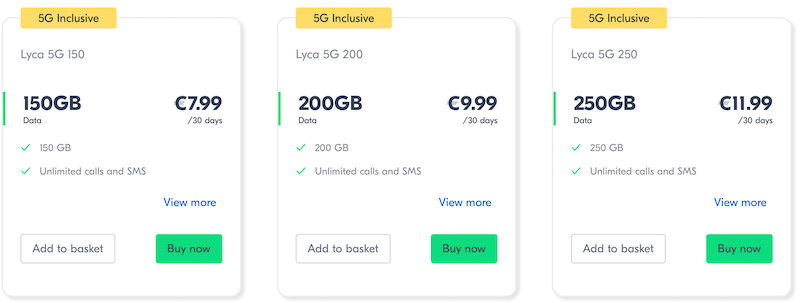
Tips on buying a SIM card in Italy
- Carry your passport, or a copy of the information page. In all likelihood, it will be needed to obtain a plan. In some countries, especially those needing a visa, the actual passport may be required.
- It pays to do your research, in advance and at your point of arrival. It’s been my experience that discounted rates are available when more than one network or reseller has a presence at an arrival airport. The rates can be more competitive than those appearing on their websites.
- Use the store locator function for the address and services of your chosen provider.
- Save every piece of documentation… receipt, pamphlet, contract, SIM card holder showing telephone number and barcode, and all texts associated with the plan.
- Ask if the dialling code is different between landline and mobile numbers. Also, is the country code needed to make in-country calls or when roaming in other EU countries?
- Ask if texts and other communications can be received in another language.
- While still in the store, download the app for checking usage. If it’s not available, ask the worker to use your phone to log into the website and set up your account. It can be expensive exceeding your allowances.
- Make sure you leave the store with your home country SIM card. Ask the worker to tape it to an empty SIM card holder, preferably the original you’ve brought from home (with a SIM card removal tool). Or, tape it to the inside of your phone case. You’ll appreciate having both at your fingertips on the flight home.
- When you eventually remove the local SIM card, tape it to the respective SIM card holder. You may be able to use it on a subsequent trip.
- Record the address of the sales outlet, and the name of the worker.
- If the sales outlet is a temporary kiosk in the arrivals terminal or outside a train station, find out where you can go for assistance later. Ask for the telephone number and online chat link where an English-speaking agent can help resolve any problems you encounter.
- If you’ll be travelling to other EU countries, check roaming limits. There may be daily limits on calling and data, or additional charges for international calls. For example, I had 8 GB of data with my plan, but usage was limited to 350 MB per day outside of Italy.
- Pay cash to avoid unexpected charges to your credit card. I was pleased that the €12 debit couldn’t find its way to my credit card account. When working across a language barrier, information on features and costs may not be clear. Texts received from the carrier on important details can be overlooked if they’re in a language that isn’t understood.
- As soon as possible, add your new phone number to your listing in your address book. If anyone asks for your number, it will be easily retrievable.
- Turn off Cellular Data when you don’t need it. Apps working in the background can seriously eat into your data allowance.
Buying a SIM card in Italy
As mentioned, I was pleased with Vodafone coverage, especially during my five-night stay in Cinque Terre. As Lyca Mobile uses the Vodafone network, I wouldn’t hesitate to drop into a Lyca Mobile store or kiosk to investigate further and possibly sign up for one of their reasonably priced plans.
Also, I would seriously consider WINDTRE given that the company has the widest coverage and nearly half the market share. Their current plans (August, 2024) are certainly affordable.
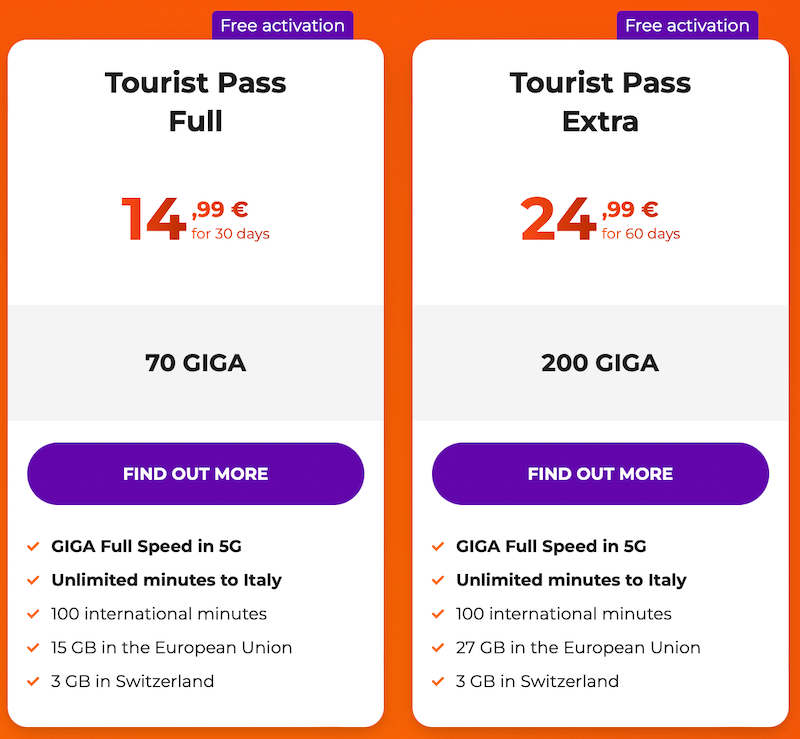
If you found this post helpful, please share it by selecting one or more social media buttons. Do you have any suggestions on buying a SIM card in Italy? If so, please add your thoughts in the comments. Thank you.
Care to pin it for later?
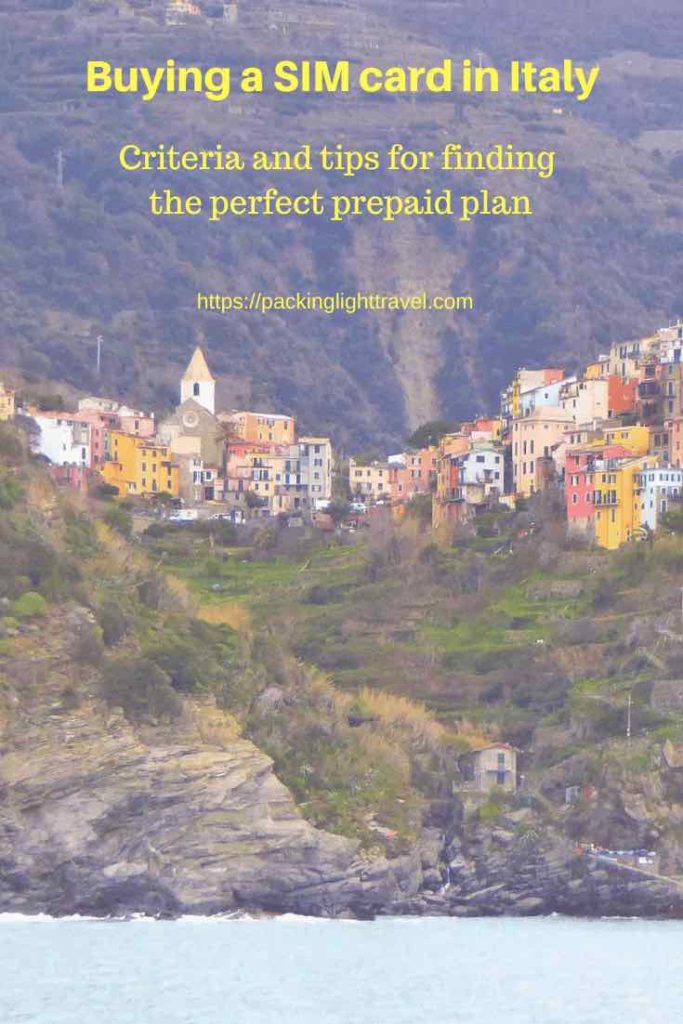


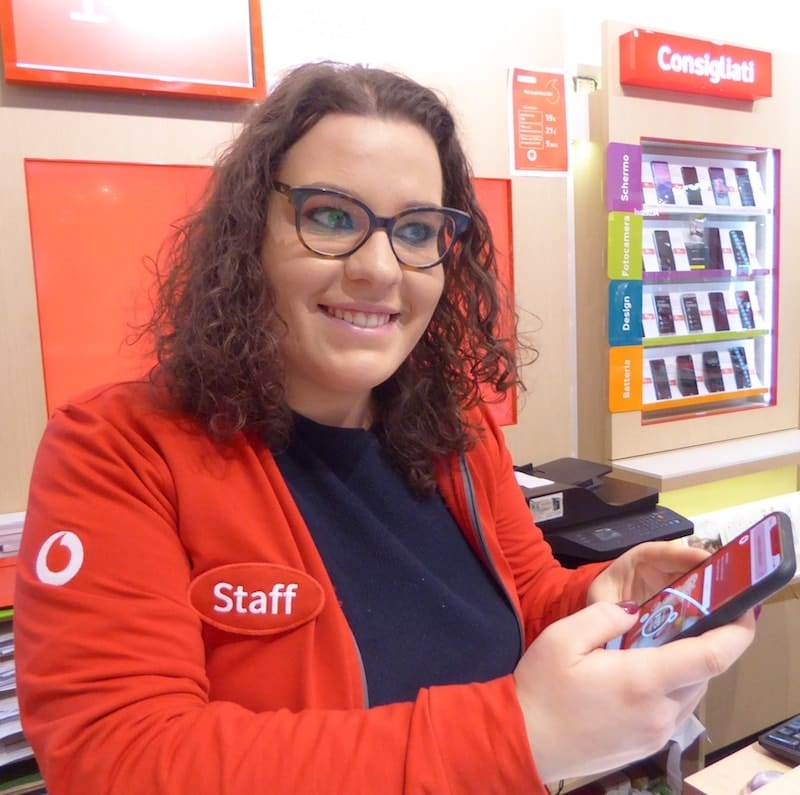
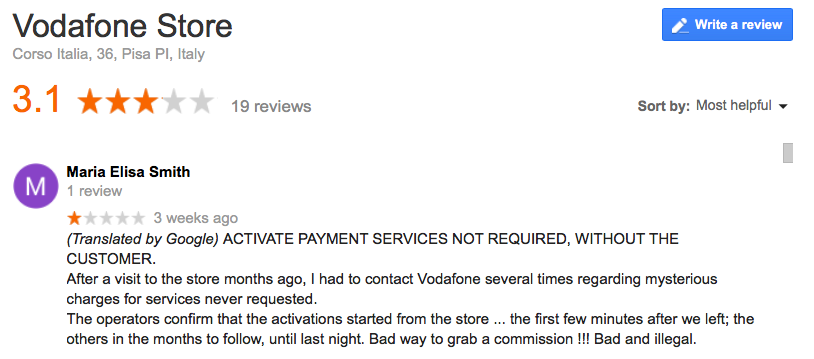




For better or worse, I use Virgin Mobile.
$10 per day unlimited calls and texts and 250 MB data. Works perfectly so far in iIreland, England, France China South Africa Spain. No new Sim card just dial the number its all automatic. If you do not use outside of Canada, then no charge
After the first twenty days the rest if the month is included.
Call locally call Canada no difference.
After getting ripped in Italy I go with this.
By the way its 6 per day in US
It is so simple, even I can figure it out
I do not have to turn it on or off, just use it in the foreign country
Great article with lots of useful information. I had an international roaming plan on my Rogers phone in Europe but data was a problem… as in I use too much of it when I travel.
At some point I’ll learn self-discipline… although I’m 60 and maybe that train has already sailed. 😉
Thanks for the detailed & helpful info. I’ve always used Vodafone in Spain & in Portugal without issues. Activation was within 10 minutes & everything worked. I plan to use the same Spanish SIM in Italy this month. If it doesn’t work, I’ll use Lyca as you suggested. Thanks again for the super helpful info.
I was totally blind to the potential problems I might encounter. Thank you for an enlightening post!
I speak a little Italian, and on one trip had bought a Vodafone card. Great, cheap, good coverage (except in mountains where there is little cellular coverage) and I can top it up periodically to use each year. Worked fine, but needed help with initial set up.
Have also had a 3card for Europe (bought online) from Britain. That was in English but was difficult to get the data working. I had to wait until I got to my Airbnb apartment to go online with my tablet to set it up. Prefer the Vodafone option, as I had a phone as soon as I landed in Rome.
According to the Lycamobile Italy website, the SIM cards are supposed to be free. Exactta at the Fiumicino airport is listed on the Lyca website as a retailer but it is not an exclusive Lyca store. It sells SIM cards together with data plans and calls. Browsing through the web, Exactta has terrible reviews.
Are there actually exclusive Lycamobile stores around Rome? Where do you get these free SIM cards? Are there instructions on the SIM card package on how to activate the SIM card?
We went to Italy last month. I purchased Ultra Mobile SIM cards at a local store in San Francisco with $19/month plan which includes $5 international roaming. It is $ 0.25/minute in Italy. I rented a wifi egg at FCO airport for about $35/week with unlimited data. I love the wifi egg(mifi) which is a life saver! With the wifi egg, I was able to make wifi calls and forwarded my office calls to the Ultra mobile number before leaving for the trip.
My suggestion: get Google Fi before leaving the US. It works in over 160 countries. You get calls, SMS and Internet access for a $20/mo access plus $10 per GB. Once you are back home you can pause the Google Fi service until next year or keep it in place of Verizon/ATT/T-Mobile and the like. We have used Google Fi in many coutries including Italy, basically any other place in Europe, India, Vietnam, Costa Rica and many other. Works like a charm and you deal with an American company instead of some bozos in Italy…
I bought an international calling and data plan from lyca usa. It worked fine here but once in Italy nothing. I was able to figure out how to to configure the phone on my own but italy lyca did not recognize my credit. Emails chat or calls to lyca went unanswered. Avoid lyca like a plauge